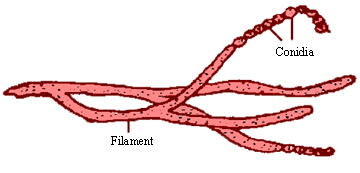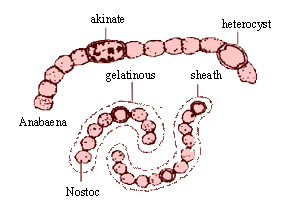|
PinkMonkey Online Study Guide-Biology
Reproduction : They reproduce both asexually as
well as sexually. Asexual reproduction is by binary fission which takes
place in favorable conditions, or by endospore formation, which takes
place in unfavorable conditions. Sexual reproduction is by conjugation.
Economic importance : Bacteria act as both friends and foes of mankind as described below:
Useful activities
(i) They increase the fertility of soil by converting atmospheric nitrogen into nitrates (nitrogen fixation), by converting ammonia derived from dead bodies into nitrates (nitrification) or by decomposing dead organic matter and forming humus which is the most fertile part of the soil.
(ii) They form symbolic association with man and animals and help in digestion.
(iii) In industry they are used in ’curdling’ of milk, ’retting of fibers’ of jute and hemp’curing’ of tea and tobacco leaves ’tanning’ of leather, production of vinegar, etc.
(iv) They are used in the production of certain antibiotic drugs.
(v) They are scavengers of nature and help to keep the environment clean and also play an important role in recycling of nutrients in nature.
Harmful activities
(i) They cause dreadful diseases in plants, animals
and human.
(ii) They spoil milk, meat, fish and vegetables.
(iii) Some of them release toxins into spoiled food and cause food poisoning.
(iv) Denitrifying bacteria reduce fertility of soil by converting nitrates into free nitrogen (denitrification).
(c) Actinomycetes (Actinos = rays, mykos = fuB>
These are prokaryotes showing characters similar to both
bacteria and fungi. Like fungi, they show filamentous bodies and they BIO reproduce by forming conidia in chains. However, like bacteria, their
BIOBIOBIOell wall is made up of peptidoglycan and not of chitin or fungal cellulose.
The nucleus is without a nuclear membrane, and sexual reproduction is
totally absent. They are regarded as intermediate between fungi and bacteria;
but because of the thin filamentous structure, they are classified with
bacteria. They may be aerobic or anaerobic, saprophytic or parasitic.

Figure 14.10 Actinomycetes
The body of actinomycetes is made up of very thin, branched filamentous structure without cross septa. The branches grow in all directions. Some of the branches are aerial and produce conidia in chain at the apices. The cell wall is made up of peptidoglycan and the protoplasm shows granules and vacuoles. They are gram positive.
Economic importance : Most of them are saprophytic,
economically important as decomposers. Several species of the group Streptomyces
produce antibiotics like streptomycin, erythromycin, tetracycline, neomycin
etc while some are pathogenic like Mycobacterium tuberculosis causing
tuberculosis in human beings, M. leprae causing leprosy,
and others causing serious lung diseases.
(d) Cyanobacteria
These were formerly known as blue green algae because of their filamentous nature. They are photosynthetic autotrophs widely distributed in nature. They are found in ponds, lakes, moist soils, logs of wood, ocean and even in hot water springs.

Figure 14.11 Cyanobacteria
|